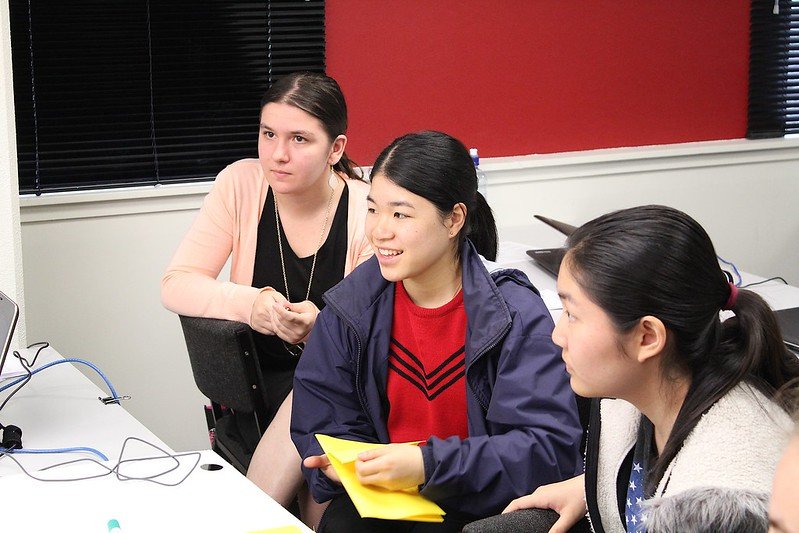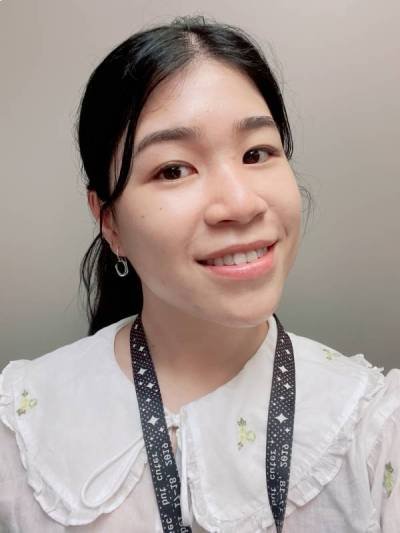by Charlotte Weston
How it all began
Doris Tam’s journey to becoming a full-time Mahara developer at Catalyst began when she was still attending high school. Her Digital Technologies teacher asked the class if anyone was interested in applying for the Catalyst Open Source Academy. Doris was among those who were selected to attend.
The Academy gave Doris a taste of what it’s like working in the tech industry. During that time she had been working part-time in a retail job, so the comparison between retail and IT wages was an incentive to continue in the IT industry. When she reached the end of high school, Doris enrolled in a Bachelor of Engineering degree at university.

Doris Tam (middle) at the Catalyst Open Source Academy
“First year uni was tough,” Doris says, “but there were so few women that you just immediately became friends with them.” The tech industry is still heavily dominated by men, which is something Catalyst is actively working to combat. Doris says women students only made up a small portion of the classes. During one paper, a university staff member told Doris that her report about a networking experience wasn’t good enough because it was about an event organised for women in tech. They told her she “should have gone to a bar and talked to a man about chess.”
Becoming an intern at Catalyst
As part of the requirements for completing her engineering degree, , Doris needed to complete 400 hours of industry experience, and a friend reminded her of Catalyst, where she had participated in the Open Source Academy close to three years prior. She searched through her emails and contacted Kristina Hoeppner, project lead of the Mahara project, who remembered Doris, and told her “we didn't plan on taking on an intern this year, but let's discuss.” That summer, Doris started as intern in the Mahara team and worked to improve the automation test suite. After her summer internship, Doris continued working part-time until the end of her studies, with support from the Catalyst team.
Working part-time as a student at Catalyst typically means up to 10 hours per week during term time, if the student wishes to work. During term breaks, students then work closer to full-time. That allows them to make bigger progress in their learning, be involved more easily in projects with deadlines, and get to know Catalyst staff and work culture more through daily interactions.
Balancing university and work
At one point during university when Doris asked for help, she was told she couldn’t get a job as she didn’t have the foundational skills, yet she’d already been working at Catalyst for two years. Doris says the things she learned in her first two years at Catalyst were more fun and more useful than what she learned at university, and even helped with her studies. “Catalyst taught me how to use the version control system Git. Before that, when I did my assignments at uni I would make changes and screw it up and couldn’t get the code back. Learning how to use the Linux terminal and Git were the most fundamental things that just saved me at uni.”
She often studied at the office as it was a more peaceful and ergonomic environment than university as she could focus more easily. The team structured Doris' work to fit work around her study obligations.
Working full-time at Catalyst

After Doris finished her studies, she transitioned seamlessly into a full-time position in the Mahara team. She has been working on a range of different projects, including leading a small team of developers to re-write Mahara Mobile, the cross-platform mobile app for Mahara in React Native. Through the client and community work that Catalyst does for Mahara, Doris is exposed to different clients, is involved in the twice yearly releases of new versions, and also already managed the release of a security release across all supported versions of Mahara.
In early 2022, Doris became an approved Mahara developer, which is a badge of honour as it indicates that the developer knows the Mahara code base well and makes changes and additions that fit into it. Approved developers also know the community's coding guidelines well to provide sound peer reviews and spot potential issues, suggest better ways of coding things, and generally have a good understanding of the technical side of the project.
Kristina says, “Applying to become an approved developer was the next natural step for Doris to progress in her career as developer on the Mahara team and take on more responsibility in her coding. Robert Lyon, our tech lead of the project, and I asked Doris to apply because we had confidence in her that she would do well with the added responsibility. We could see that she was ready to be more proactive. She had also demonstrated that she could give good feedback to other developers, which is a large part of our peer review process.”
“I like the open source part of Mahara,” Doris says. “Because we support the entire community as maintainers of the software rather than only do client work, we work with people from around the world and learn how they are using the software, which helps us in developing new features on our own and not just through our clients. Being able to engage with the Mahara community is great, knowing it’s not just a one-off six-month client project. That means we are able to plan ahead for new features, though we do balance it with our obligations towards our clients. We are in the great position that the majority of our clients here in Aotearoa and also abroad are happy for us to contribute changes and new features back to the community to enhance the software for all.”